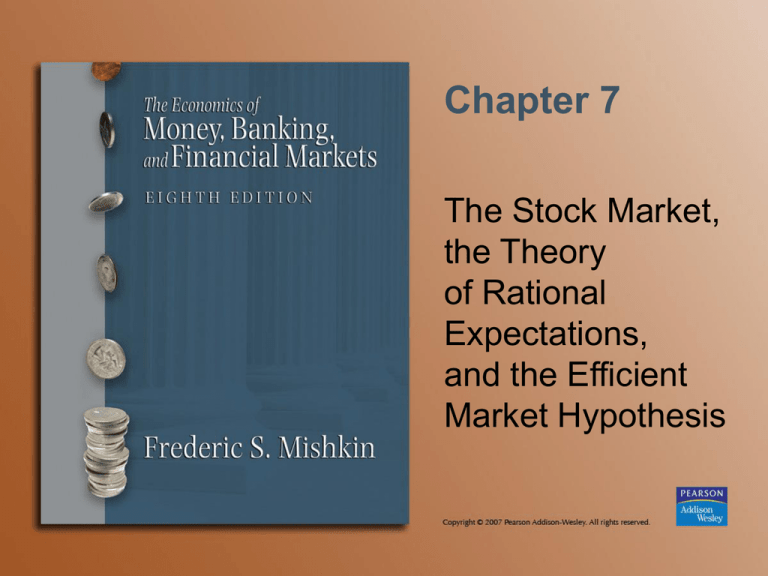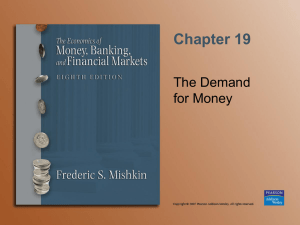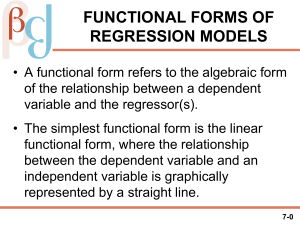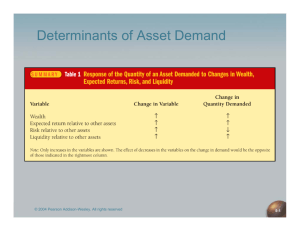
Chapter 7
The Stock Market,
the Theory
of Rational
Expectations,
and the Efficient
Market Hypothesis
One-Period Valuation Model
Div1
P1
P0
(1 ke ) (1 ke )
P0 = the current price of the stock
Div1 = the dividend paid at the end of year 1
ke = the required return on investment in equity
P1 = the sale price of the stock at the end of the first period
Copyright © 2007 Pearson Addison-Wesley. All rights reserved.
7-2
Generalized Dividend
Valuation Model
The value of stock today is the present value of all future cash flows
P0
Dn
Pn
D1
D2
...
(1 ke )1 (1 ke ) 2
(1 ke ) n (1 ke ) n
If Pn is far in the future, it will not affect P0
P0
t 1
Dt
(1 ke )t
The price of the stock is determined only by the present value of
the future dividend stream
Copyright © 2007 Pearson Addison-Wesley. All rights reserved.
7-3
Gordon Growth Model
D0 (1 g)
D1
P0
(ke g) (ke g)
D0 = the most recent dividend paid
g = the expected constant growth rate in dividends
ke = the required return on an investment in equity
Dividends are assumed to continue growing at a constant rate forever
The growth rate is assumed to be less than the required return on equity
Copyright © 2007 Pearson Addison-Wesley. All rights reserved.
7-4
How the Market Sets Prices
• The price is set by the buyer willing to
pay the highest price
• The market price will be set by the
buyer who can take best advantage of
the asset
• Superior information about an asset can
increase its value by reducing its risk
Copyright © 2007 Pearson Addison-Wesley. All rights reserved.
7-5
Theory of Rational Expectations
• Expectations will be identical to optimal
forecasts using all available information
• Even though a rational expectation equals the
optimal forecast using all available
information, a prediction based on it may not
always be perfectly accurate
It takes too much effort to make the expectation the
best guess possible
Best guess will not be accurate because predictor
is unaware of some relevant information
Copyright © 2007 Pearson Addison-Wesley. All rights reserved.
7-6
Formal Statement of the Theory
X e X of
X expectation of the variable that is being forecast
e
X of = optimal forecast using all available information
Copyright © 2007 Pearson Addison-Wesley. All rights reserved.
7-7
Implications
• If there is a change in the way a variable
moves, the way in which expectations
of the variable are formed will change
as well
• The forecast errors of expectations will,
on average, be zero and cannot be
predicted ahead of time
Copyright © 2007 Pearson Addison-Wesley. All rights reserved.
7-8
Efficient Markets—
Application of Rational Expectations
Recall
The rate of return from holding a security equals the sum of the capital
gain on the security, plus any cash payments divided by the
initial purchase price of the security.
Pt 1 Pt C
R
Pt
R = the rate of return on the security
Pt 1 = price of the security at time t + 1, the end of the holding period
Pt = price of the security at time t , the beginning of the holding period
C = cash payment (coupon or dividend) made during the holding period
Copyright © 2007 Pearson Addison-Wesley. All rights reserved.
7-9
Efficient Markets (cont’d)
At the beginning of the holding period, we know Pt and C.
Pt 1 is unknown and we must form an expectation of it.
The expected return then is
Pt e1 Pt C
R
Pt
e
Expectations of future prices are equal to optimal forecasts using
all currently available information so
Pt e1 Pt of1 R e R of
Supply & demand analysis states R e will equal the equilibrium return R* so
R of R*
Copyright © 2007 Pearson Addison-Wesley. All rights reserved.
7-10
Efficient Markets
• Current prices in a financial market will
be set so that the optimal forecast of a
security’s return using all available
information equals the security’s
equilibrium return
• In an efficient market, a security’s price
fully reflects all available information
Copyright © 2007 Pearson Addison-Wesley. All rights reserved.
7-11
Rationale
R of R* Pt R of
R of R* Pt R of
until
R of R*
In an efficient market, all unexploited profit opportunities will
be eliminated
Copyright © 2007 Pearson Addison-Wesley. All rights reserved.
7-12
Evidence in Favor of
Market Efficiency
• Having performed well in the past does not
indicate that an investment advisor or a mutual
fund will perform well in the future
• If information is already publicly available, a
positive announcement does not, on average,
cause stock prices to rise
• Stock prices follow a random walk
• Technical analysis cannot successfully predict
changes in stock prices
Copyright © 2007 Pearson Addison-Wesley. All rights reserved.
7-13
Evidence Against Market Efficiency
•
•
•
•
•
•
Small-firm effect
January Effect
Market Overreaction
Excessive Volatility
Mean Reversion
New information is not always
immediately incorporated into
stock prices
Copyright © 2007 Pearson Addison-Wesley. All rights reserved.
7-14
Application Investing in the
Stock Market
• Recommendations from investment advisors
cannot help us outperform the market
• A hot tip is probably information already
contained in the price of the stock
• Stock prices respond to announcements only
when the information is new and unexpected
• A “buy and hold” strategy is the most sensible
strategy for the small investor
Copyright © 2007 Pearson Addison-Wesley. All rights reserved.
7-15
Behavioral Finance
• The lack of short selling (causing
over-priced stocks) may be explained by
loss aversion
• The large trading volume may be
explained by investor overconfidence
• Stock market bubbles may be explained
by overconfidence and social contagion
Copyright © 2007 Pearson Addison-Wesley. All rights reserved.
7-16












